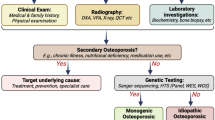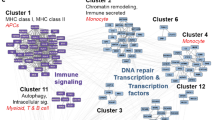Abstract
Summary
The molecular mechanism of osteoporosis (OP) in Kashin-Beck disease (KBD) patients was unclear. Our results suggest that KBD and OP shared some common causal genes, functionally involved in skeletal growth and development and chronic inflammation. Our results provide novel clues for clarifying the molecular mechanism of OP in KBD patients.
Introduction
KBD is a chronic skeletal disorder with osteopenia and OP. The pathogenesis of OP in KBD patients remains elusive.
Methods
A total of 1717 subjects participated in this study. KBD was diagnosed according to the clinical diagnosis criteria of China (GB16395-1996). The bone mineral density (BMD) and bone areas of the ulna and radius, hip, and lumbar (L1–L4) were measured with a Hologic 4500 W dual-energy X-ray absorptiometry scanner. Genotyping was conducted using Affymetrix SNP Array 6.0. Gene expression profiling of peripheral blood mononuclear cells of KBD and OP patients were compared using Affymetrix HG-U133 plus 2.0 arrays and Agilent Human 1A arrays, respectively. Genome-wide association studies (GWAS) were conducted by PLINK. SCEA and DAVID were applied for pleiotropy and functional enrichment analysis, respectively.
Results
SCEA analysis observed significant pleiotropic effects between KBD and the ulna and radius BMD (P value = 5.99 × 10−3). GWAS meta-analysis identified six candidate genes with pleiotropic effects, including PDGFD, SOX5, DPYD, CTR9, SPP1, and COL4A1. GO analysis identified 16 significant GO shared by KBD and the ulna and radius BMD, involved in cell morphogenesis and apoptosis. Pathway enrichment analysis detected two common pathways for KBD and the ulna and radius BMD, including calcium signaling pathway and vascular smooth muscle contraction pathway. Gene expression analysis detected three up-regulated inflammation-related genes for KBD and OP, including IL1B, IL8, and CCL1.
Conclusion
This study reported several candidate genes involved in the development of OP in KBD patients.

Similar content being viewed by others
References
Moreno-Reyes R, Suetens C, Mathieu F, Begaux F, Zhu D, Rivera MT, Boelaert M, Neve J, Perlmutter N, Vanderpas J (1998) Kashin-Beck osteoarthropathy in rural Tibet in relation to selenium and iodine status. N Engl J Med 339:1112–1120
Stone R (2009) Diseases. A medical mystery in middle China. Science 324:1378–1381
Lu AL, Guo X, Aisha MM, Shi XW, Zhang YZ, Zhang YY (2010) Kashin-Beck disease and Sayiwak disease in China: prevalence and a comparison of the clinical manifestations, familial aggregation, and heritability. Bone 48(2):347–353
Shi XW, Guo X, Lv AL, Kang L, Zhou YL, Zhang YZ, Wu XM, Bai YD (2010) Heritability estimates and linkage analysis of 23 short tandem repeat loci on chromosomes 2, 11, and 12 in an endemic osteochondropathy in China. Scand J Rheumatol 39:259–265
Shi Y, Lu F, Liu X et al (2011) Genetic variants in the HLA-DRB1 gene are associated with Kashin-Beck disease in the Tibetan population. Arthritis Rheum 63:3408–3416
Chen Z, Zheng G, Ghosh K, Li Z (2005) Linkage disequilibrium mapping of quantitative-trait loci by selective genotyping. Am J Hum Genet 77:661–669
Xiong YM, Mo XY, Zou XZ, Song RX, Sun WY, Lu W, Chen Q, Yu YX, Zang WJ (2010) Association study between polymorphisms in selenoprotein genes and susceptibility to Kashin-Beck disease. Osteoarthr Cartil/OARS, Osteoarthr Res Soc 18:817–824
Purcell S, Neale B, Todd-Brown K et al (2007) PLINK: a tool set for whole-genome association and population-based linkage analyses. Am J Hum Genet 81:559–575
Price AL, Patterson NJ, Plenge RM, Weinblatt ME, Shadick NA, Reich D (2006) Principal components analysis corrects for stratification in genome-wide association studies. Nat Genet 38:904–909
Duan C, Guo X, Zhang XD, Yu HJ, Yan H, Gao Y, Ma WJ, Gao ZQ, Xu P, Lammi M (2010) Comparative analysis of gene expression profiles between primary knee osteoarthritis and an osteoarthritis endemic to Northwestern China, Kashin-Beck disease. Arthritis Rheum 62:771–780
Nyholt DR (2014) SECA: SNP effect concordance analysis using genome-wide association summary results. Bioinformatics 30:2086–2088
Wang SJ, Guo X, Zuo H, Zhang YG, Xu P, Ping ZG, Zhang Z, Geng D (2006) Chondrocyte apoptosis and expression of Bcl-2, Bax, Fas, and iNOS in articular cartilage in patients with Kashin-Beck disease. J Rheumatol 33:615–619
Liu JT, Guo X, Ma WJ, Zhang YG, Xu P, Yao JF, Bai YD (2010) Mitochondrial function is altered in articular chondrocytes of an endemic osteoarthritis, Kashin-Beck disease. Osteoarthr Cartil/OARS, Osteoarthr Res Soc 18:1218–1226
Weinstein RS, Manolagas SC (2000) Apoptosis and osteoporosis. Am J Med 108:153–164
Li F, Sun X, Ma J, Ma X, Zhao B, Zhang Y, Tian P, Li Y, Han Z (2014) Naringin prevents ovariectomy-induced osteoporosis and promotes osteoclasts apoptosis through the mitochondria-mediated apoptosis pathway. Biochem Biophys Res Commun 452:629–635
Tai TW, Su FC, Chen CY, Jou IM, Lin CF (2014) Activation of p38 MAPK-regulated Bcl-xL signaling increases survival against zoledronic acid-induced apoptosis in osteoclast precursors. Bone 67:166–174
Huser CA, Davies ME (2007) Calcium signaling leads to mitochondrial depolarization in impact-induced chondrocyte death in equine articular cartilage explants. Arthritis Rheum 56:2322–2334
Han SK, Wouters W, Clark A, Herzog W (2012) Mechanically induced calcium signaling in chondrocytes in situ. J Orthop Res: Off Publ OrthopRes Soc 30:475–481
Zayzafoon M (2006) Calcium/calmodulin signaling controls osteoblast growth and differentiation. J Cell Biochem 97:56–70
Hwang SY, Putney JW Jr (2011) Calcium signaling in osteoclasts. Biochim Biophys Acta 1813:979–983
Choi ST, Kim JH, Kang EJ, Lee SW, Park MC, Park YB, Lee SK (2008) Osteopontin might be involved in bone remodelling rather than in inflammation in ankylosing spondylitis. Rheumatology (Oxford) 47:1775–1779
Reinholt FP, Hultenby K, Oldberg A, Heinegard D (1990) Osteopontin—a possible anchor of osteoclasts to bone. Proc Natl Acad Sci U S A 87:4473–4475
Xu G, Sun W, He D, Wang L, Zheng W, Nie H, Ni L, Zhang D, Li N, Zhang J (2005) Overexpression of osteopontin in rheumatoid synovial mononuclear cells is associated with joint inflammation, not with genetic polymorphism. J Rheumatol 32:410–416
Lefebvre V, Li P, de Crombrugghe B (1998) A new long form of Sox5 (L-Sox5), Sox6 and Sox9 are coexpressed in chondrogenesis and cooperatively activate the type II collagen gene. EMBO J 17:5718–5733
Aza-Carmona M, Shears DJ, Yuste-Checa P et al (2011) SHOX interacts with the chondrogenic transcription factors SOX5 and SOX6 to activate the aggrecan enhancer. Hum Mol Genet 20:1547–1559
Canalis E, McCarthy TL, Centrella M (1989) Effects of platelet-derived growth factor on bone formation in vitro. J Cell Physiol 140:530–537
Elangovan S, D’Mello SR, Hong L, Ross RD, Allamargot C, Dawson DV, Stanford CM, Johnson GK, Sumner DR, Salem AK (2014) The enhancement of bone regeneration by gene activated matrix encoding for platelet derived growth factor. Biomaterials 35:737–747
Tian L, Wang W, Hou W et al (2011) Autoimmune and inflammatory responses in Kashin-Beck disease compared with rheumatoid arthritis and osteoarthritis. Hum Immunol 72:812–816
Zhou X, Wang Z, Chen J, Wang W, Song D, Li S, Yang H, Xue S, Chen C (2014) Increased levels of IL-6, IL-1beta, and TNF-alpha in Kashin-Beck disease and rats induced by T-2 toxin and selenium deficiency. Rheumatol Int 34:995–1004
Yang TF, Wang G, Tong W, Gong Q, Cheng Y (2001) Measurement of the bioactivity of interleukin and tumour necrosis factor in synovial fluid of Kashin-Beck disease. Int Orthop 25:162–163
Barbour KE, Boudreau R, Danielson ME et al (2012) Inflammatory markers and the risk of hip fracture: the women’s health initiative. J Bone Miner Res: Off J Am Soc Bone Miner Res 27:1167–1176
Barbour KE, Lui LY, Ensrud KE, Hillier TA, LeBlanc ES, Ing SW, Hochberg MC, Cauley JA, Study of Osteoporotic Fractures Research G (2014) Inflammatory markers and risk of hip fracture in older white women: the study of osteoporotic fractures. J Bone Miner Res: Off J Am Soc Bone MinerRes 29:2057–2064
Acknowledgments
The study was supported by the National Natural Scientific Fund of China (81472925), Science and Technology Research and Development Program of Shaanxi Province of China (2013KJXX-51).
Author information
Authors and Affiliations
Corresponding author
Ethics declarations
Conflicts of interest
None.
Electronic supplementary material
Below is the link to the electronic supplementary material.
Fig. S1
Quantile-quantile plot of GWAS meta-analysis results of KBD and the ulna and radius BMD. (GIF 121 kb)
Rights and permissions
About this article
Cite this article
Wen, Y., Guo, X., Hao, J. et al. Integrative analysis of genome-wide association studies and gene expression profiles identified candidate genes for osteoporosis in Kashin-Beck disease patients. Osteoporos Int 27, 1041–1046 (2016). https://doi.org/10.1007/s00198-015-3364-y
Received:
Accepted:
Published:
Issue Date:
DOI: https://doi.org/10.1007/s00198-015-3364-y




